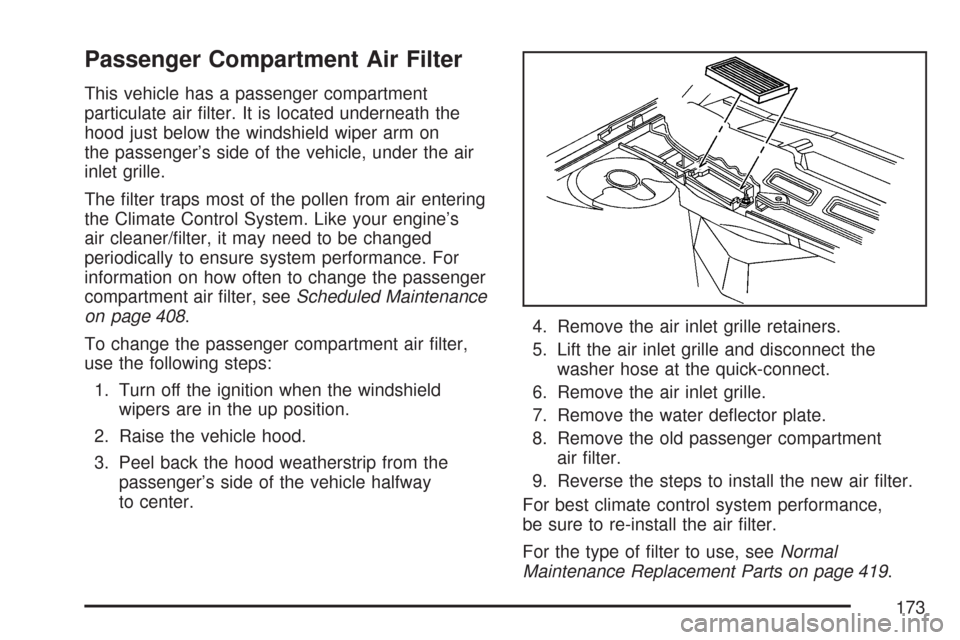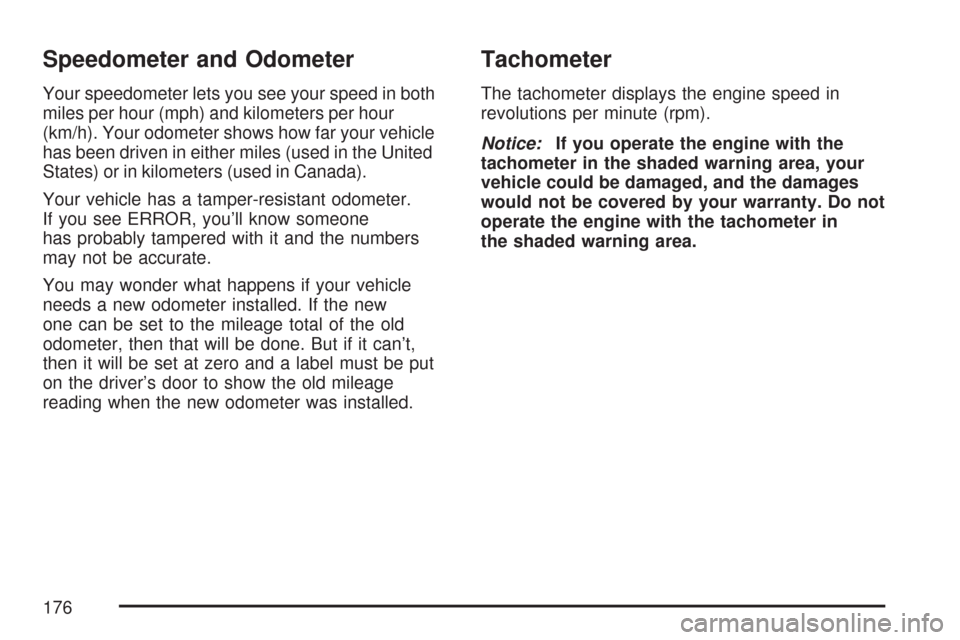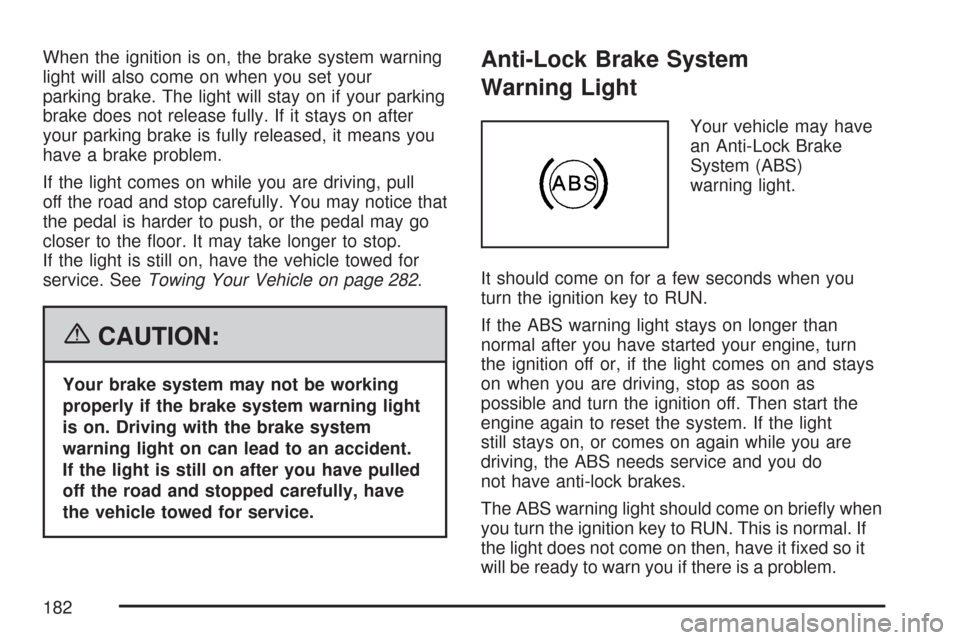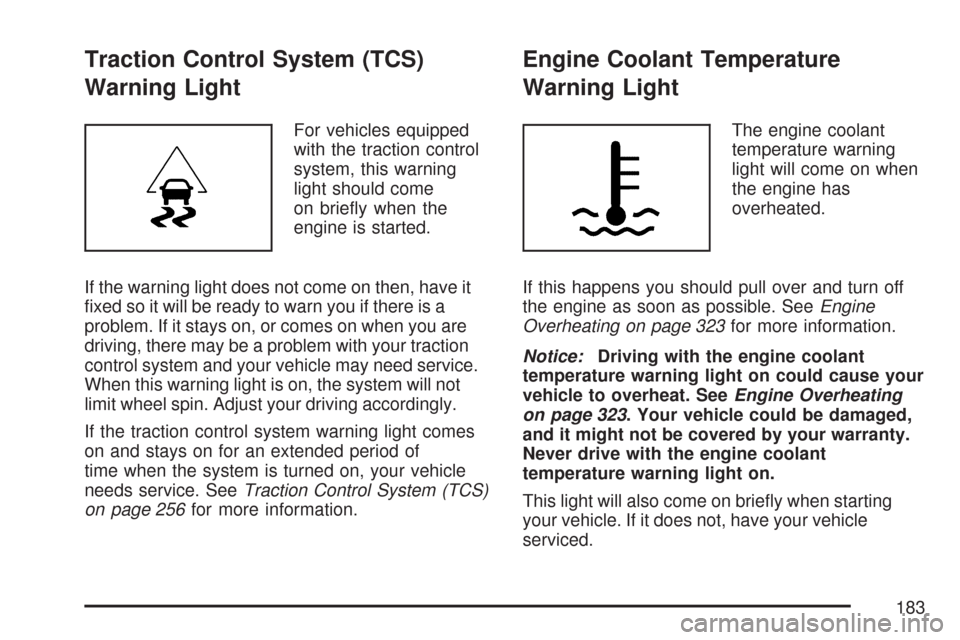2007 CHEVROLET IMPALA engine
[x] Cancel search: enginePage 166 of 460

The battery can be discharged at idle if the
electrical loads are very high. This is true for all
vehicles. This is because the generator (alternator)
may not be spinning fast enough at idle to
produce all the power that is needed for very high
electrical loads.
A high electrical load occurs when several of the
following loads are on: headlamps, high beams,
fog lamps, rear window defogger, climate
control fan at high speed, heated seats, engine
cooling fans, trailer loads, and loads plugged into
accessory power outlets.
EPM works to prevent excessive discharge of the
battery. It does this by balancing the generator’s
output and the vehicle’s electrical needs. It
can increase engine idle speed to generate more
power, whenever needed. It can temporarily
reduce the power demands of some accessories.
Normally, these actions occur in steps or levels,
without being noticeable. In rare cases at the
highest levels of corrective action, this action
may be noticeable to the driver. If so, a Driver
Information Center (DIC) message might be
displayed, such as Battery Saver Active or
Service Battery Charging System.If this message is displayed, it is recommended
that the driver reduce the electrical loads as much
as possible. SeeDIC Warnings and Messages
on page 199.
Battery Run-Down Protection
This vehicle has a feature to help prevent the
battery from being drained, if the interior courtesy
lamps, reading/map lamps, visor vanity lamps
or trunk lamp are accidentally left on. If any
of these lamps are left on, they will automatically
turn off after 10 minutes, if the ignition is off.
The lamps will not come back on again until
one of the following occurs:
The ignition is turned on.
The exterior lamps control is turned off, then
on again.
The headlamps will timeout after 10 minutes, if they
are manually turned on before the ignition is off.
166
Page 171 of 460

Using these settings together for long periods of
time may cause the air inside of your vehicle
to become too dry. To prevent this from
happening, after the air inside of your vehicle has
cooled, turn the recirculation mode off.
The air conditioning system removes moisture
from the air, so you may sometimes notice a small
amount of water dripping underneath your
vehicle while idling or after turning off the engine.
This is normal.
Defogging and Defrosting
Fog on the inside of the windows is a result of
high humidity (moisture) condensing on the
cool window glass. This can be minimized if the
climate control system is used properly. There are
two modes to clear fog or frost from your
windshield. Use the defog mode to clear the
windows of fog or moisture and warm the
passengers. Use the defrost mode to remove fog
or frost from the windshield more quickly.Do not drive the vehicle until all the windows
are clear.
Turn the right knob clockwise to select the defog
or defrost mode.
-(Defog):This mode directs air equally to the
windshield and the �oor outlets. When defog
is selected, the system turns off recirculation and
runs the air conditioning compressor unless
the outside temperature is below 40°F (4°C).
0(Defrost):This mode directs most of the air to
the windshield with some air to the side window
vents and the �oor vents. When defrost is selected,
the system will automatically force outside air into
the vehicle. The air conditioning compressor will run
automatically in this setting, unless the outside
temperature is below 40°F (4°C).
171
Page 173 of 460

Passenger Compartment Air Filter
This vehicle has a passenger compartment
particulate air �lter. It is located underneath the
hood just below the windshield wiper arm on
the passenger’s side of the vehicle, under the air
inlet grille.
The �lter traps most of the pollen from air entering
the Climate Control System. Like your engine’s
air cleaner/�lter, it may need to be changed
periodically to ensure system performance. For
information on how often to change the passenger
compartment air �lter, seeScheduled Maintenance
on page 408.
To change the passenger compartment air �lter,
use the following steps:
1. Turn off the ignition when the windshield
wipers are in the up position.
2. Raise the vehicle hood.
3. Peel back the hood weatherstrip from the
passenger’s side of the vehicle halfway
to center.4. Remove the air inlet grille retainers.
5. Lift the air inlet grille and disconnect the
washer hose at the quick-connect.
6. Remove the air inlet grille.
7. Remove the water de�ector plate.
8. Remove the old passenger compartment
air �lter.
9. Reverse the steps to install the new air �lter.
For best climate control system performance,
be sure to re-install the air �lter.
For the type of �lter to use, seeNormal
Maintenance Replacement Parts on page 419.
173
Page 174 of 460

Warning Lights, Gages, and
Indicators
This part describes the warning lights and
gages on your vehicle. The pictures help to
locate them.
Warning lights and gages can signal that
something is wrong before it becomes serious
enough to cause an expensive repair or
replacement. Paying attention to the warning lights
and gages could also save you or others from
injury.
Warning lights come on when there may be or
is a problem with one of your vehicle’s functions.
As the details show on the next few pages,
some warning lights come on brie�y when you
start the engine just to let you know they are
working. If you are familiar with this section,
you should not be alarmed when this happens.Gages can indicate when there may be or is a
problem with one of your vehicle’s functions. Often
gages and warning lights work together to let you
know when there is a problem with your vehicle.
When one of the warning lights comes on and
stays on as you are driving, or when one of the
gages shows there may be a problem, check
the section that tells you what to do about
it. Please follow this manual’s advice. Waiting to
do repairs can be costly and even dangerous.
So please get to know your vehicle’s warning lights
and gages. They can be a big help.
Your vehicle may also have a Driver Information
Center (DIC) that works along with the warning
lights and gages. SeeDriver Information
Center (DIC) on page 190for more information.
174
Page 176 of 460

Speedometer and Odometer
Your speedometer lets you see your speed in both
miles per hour (mph) and kilometers per hour
(km/h). Your odometer shows how far your vehicle
has been driven in either miles (used in the United
States) or in kilometers (used in Canada).
Your vehicle has a tamper-resistant odometer.
If you see ERROR, you’ll know someone
has probably tampered with it and the numbers
may not be accurate.
You may wonder what happens if your vehicle
needs a new odometer installed. If the new
one can be set to the mileage total of the old
odometer, then that will be done. But if it can’t,
then it will be set at zero and a label must be put
on the driver’s door to show the old mileage
reading when the new odometer was installed.
Tachometer
The tachometer displays the engine speed in
revolutions per minute (rpm).
Notice:If you operate the engine with the
tachometer in the shaded warning area, your
vehicle could be damaged, and the damages
would not be covered by your warranty. Do not
operate the engine with the tachometer in
the shaded warning area.
176
Page 181 of 460

Charging System Light
The charging system
light will come on brie�y
when you turn on
the ignition, but the
engine is not running,
as a check to show you
it is working.
It should go out once the engine is running.
If it stays on, or comes on while you are driving,
you may have a problem with the charging system.
It could indicate that you have problems with a
generator drive belt, or another electrical problem.
Have it checked right away. Driving while this
light is on could drain your battery.
If you must drive a short distance with the light on,
be certain to turn off all your accessories, such
as the radio and air conditioner.
Brake System Warning Light
Your vehicle’s hydraulic brake system is divided
into two parts. If one part is not working, the other
part can still work and stop you. For good braking,
though, you need both parts working well.
If the warning light comes on, there is a brake
problem. Have your brake system inspected
right away.
This light should come on brie�y when you turn
the ignition key to RUN. If it does not come
on then, have it �xed so it will be ready to warn
you if there is a problem.
United StatesCanada
181
Page 182 of 460

When the ignition is on, the brake system warning
light will also come on when you set your
parking brake. The light will stay on if your parking
brake does not release fully. If it stays on after
your parking brake is fully released, it means you
have a brake problem.
If the light comes on while you are driving, pull
off the road and stop carefully. You may notice that
the pedal is harder to push, or the pedal may go
closer to the �oor. It may take longer to stop.
If the light is still on, have the vehicle towed for
service. SeeTowing Your Vehicle on page 282.
{CAUTION:
Your brake system may not be working
properly if the brake system warning light
is on. Driving with the brake system
warning light on can lead to an accident.
If the light is still on after you have pulled
off the road and stopped carefully, have
the vehicle towed for service.
Anti-Lock Brake System
Warning Light
Your vehicle may have
an Anti-Lock Brake
System (ABS)
warning light.
It should come on for a few seconds when you
turn the ignition key to RUN.
If the ABS warning light stays on longer than
normal after you have started your engine, turn
the ignition off or, if the light comes on and stays
on when you are driving, stop as soon as
possible and turn the ignition off. Then start the
engine again to reset the system. If the light
still stays on, or comes on again while you are
driving, the ABS needs service and you do
not have anti-lock brakes.
The ABS warning light should come on brie�y when
you turn the ignition key to RUN. This is normal. If
the light does not come on then, have it �xed so it
will be ready to warn you if there is a problem.
182
Page 183 of 460

Traction Control System (TCS)
Warning Light
For vehicles equipped
with the traction control
system, this warning
light should come
on brie�y when the
engine is started.
If the warning light does not come on then, have it
�xed so it will be ready to warn you if there is a
problem. If it stays on, or comes on when you are
driving, there may be a problem with your traction
control system and your vehicle may need service.
When this warning light is on, the system will not
limit wheel spin. Adjust your driving accordingly.
If the traction control system warning light comes
on and stays on for an extended period of
time when the system is turned on, your vehicle
needs service. SeeTraction Control System (TCS)
on page 256for more information.
Engine Coolant Temperature
Warning Light
The engine coolant
temperature warning
light will come on when
the engine has
overheated.
If this happens you should pull over and turn off
the engine as soon as possible. SeeEngine
Overheating on page 323for more information.
Notice:Driving with the engine coolant
temperature warning light on could cause your
vehicle to overheat. SeeEngine Overheating
on page 323. Your vehicle could be damaged,
and it might not be covered by your warranty.
Never drive with the engine coolant
temperature warning light on.
This light will also come on brie�y when starting
your vehicle. If it does not, have your vehicle
serviced.
183